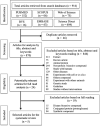Insulin-Like Proteins in Plant Sources: A Systematic Review
- PMID: 33061503
- PMCID: PMC7533237
- DOI: 10.2147/DMSO.S256883
Insulin-Like Proteins in Plant Sources: A Systematic Review
Abstract
Type 2 diabetes mellitus (T2DM) is characterized by hyperglycemia. Proteins in plant sources that enable the maintenance of the glycemic profile may be of interest in the context of T2DM. However, their mechanisms of action are unclear, unlike other bioactive compounds. This systematic review identified and described the mechanisms of action of isolated and purified proteins and peptides extracted from vegetables on the reduction of blood glucose in T2DM in experimental studies. The research was done in PubMed, ScienceDirect, Scopus, Web of Science, Embase and Virtual Health Library (VHL) databases in March 2019. The initial search retrieved 916 articles, and, after reading the title, abstract and keywords, 24 articles were eligible for full reading. Then, five articles were eligible to build this systematic review. The evaluation of the evidence and the strength of the recommendations of the studies was evaluated with the SYstematic Review Center for Laboratory animal Experimentation - SYRCLE. Studies with proteins or peptides extracted from soybean (Glycine max), corn (Zea mays), peas (Pisum sativum), costus (Costus igneus) and ginseng (Panax ginseng) were found, and all of them decreased glycemia but not by the same mechanisms. The mechanism of action of proteins extracted from Glycine max, Pisum sativum, Costus igneus were similar, acting in the insulin-mediated pathways. The peptide derived from Zea mays increased GLP-1 expression, and the peptide from Panax ginseng reduced NF-kB signaling, both resulting in stimulating the release of insulin. Therefore, bioactive proteins and peptides of plant sources act through biochemical pathways, in the modulation of insulin resistance and the hyperglycemic state. These compounds are promising in scientific research on T2DM, because there is a probable similarity of these proteins with insulin, which enables them to act as insulin-like molecules.
Keywords: bioactive proteins; hyperglycemia; hyperinsulinemia; hypoglycemic agent; plant peptides; plant proteins.
© 2020 Costa et al.
Conflict of interest statement
The authors report no conflicts of interest for this work.
Figures


Similar articles
-
Mechanism of the action of bioactive proteins of vegetables in diabetes mellitus type 2: Systematic review protocol.Medicine (Baltimore). 2019 Sep;98(39):e17326. doi: 10.1097/MD.0000000000017326. Medicine (Baltimore). 2019. PMID: 31574867 Free PMC article.
-
Renshen (Panax ginseng) and Huanglian (Rhizoma Coptidis) For T2DM: A protocol of systematic review and meta-analysis of randomized clinical trials.Medicine (Baltimore). 2021 Jan 15;100(2):e23743. doi: 10.1097/MD.0000000000023743. Medicine (Baltimore). 2021. PMID: 33466125 Free PMC article.
-
Folic acid supplementation and malaria susceptibility and severity among people taking antifolate antimalarial drugs in endemic areas.Cochrane Database Syst Rev. 2022 Feb 1;2(2022):CD014217. doi: 10.1002/14651858.CD014217. Cochrane Database Syst Rev. 2022. PMID: 36321557 Free PMC article.
-
The value of short- and long-acting glucagon-like peptide-1 agonists in the management of type 2 diabetes mellitus: experience with exenatide.Curr Med Res Opin. 2016;32(1):61-76. doi: 10.1185/03007995.2015.1103214. Epub 2015 Nov 11. Curr Med Res Opin. 2016. PMID: 26439329 Review.
-
The effect of ginseng (the genus panax) on glycemic control: a systematic review and meta-analysis of randomized controlled clinical trials.PLoS One. 2014 Sep 29;9(9):e107391. doi: 10.1371/journal.pone.0107391. eCollection 2014. PLoS One. 2014. PMID: 25265315 Free PMC article. Review.
Cited by
-
In-vivo anti-hyperglycemic effect of herbal extracts Tribulus terrestris (L) and Curcuma amada (R) on streptozotocin-induced diabetic rats and its associated histopathological studies.Heliyon. 2024 Jan 4;10(1):e24009. doi: 10.1016/j.heliyon.2024.e24009. eCollection 2024 Jan 15. Heliyon. 2024. PMID: 38230238 Free PMC article.
-
A Review on the Antidiabetic Properties of Moringa oleifera Extracts: Focusing on Oxidative Stress and Inflammation as Main Therapeutic Targets.Front Pharmacol. 2022 Jul 11;13:940572. doi: 10.3389/fphar.2022.940572. eCollection 2022. Front Pharmacol. 2022. PMID: 35899107 Free PMC article. Review.
-
Proteins and Peptides Studied In Silico and In Vivo for the Treatment of Diabetes Mellitus: A Systematic Review.Nutrients. 2024 Jul 24;16(15):2395. doi: 10.3390/nu16152395. Nutrients. 2024. PMID: 39125276 Free PMC article. Review.
-
The SWGEDWGEIW from Soybean Peptides Reduces Insulin Resistance in 3T3-L1 Adipocytes by Activating p-Akt/GLUT4 Signaling Pathway.Molecules. 2023 Mar 28;28(7):3001. doi: 10.3390/molecules28073001. Molecules. 2023. PMID: 37049764 Free PMC article.
-
Nanoparticles Containing Tamarind Isolate Protein Potentiate the Satiety without Promoting the Anti-Inflammatory Effect in a Preclinical Model of Diet-Induced Obesity.Foods. 2022 Nov 5;11(21):3526. doi: 10.3390/foods11213526. Foods. 2022. PMID: 36360138 Free PMC article.
References
-
- Aronoff SL, Berkowitz K, Shreiner B, Want L. Glucose metabolism and regulation: beyond insulin and glucagon. Diabetes Spectr. 2004;17(3):183–190. doi:10.2337/diaspect.17.3.183 - DOI
Publication types
Grants and funding
LinkOut - more resources
Full Text Sources

